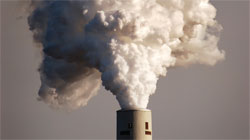The Environmental Protection Agency (EPA) has proposed the first-ever limits on carbon dioxide emissions from existing power plants, designed to begin to address the consequences of climate change. The agency has proposed a flexible framework that allows states to decide for themselves how to meet the emissions reductions targets. For many states, the required emissions reductions are actually quite modest, and at UCS we see an opportunity for states to be more ambitious in developing renewable energy in particular. Here I explore what the carbon standard means for Pennsylvania.
Pennsylvania’s Target
Continuing an unprecedented level of stakeholder engagement over the last year, the EPA is holding a series of public hearings this week to solicit comments on the standard—one of those hearings will be held in Pittsburgh on July 31 and August 1. Pennsylvania relies on coal for about 40% of its electricity, with another 35% from nuclear, and 21% from natural gas (see chart below).

Pennsylvania’s Electricity Mix in 2013 (Source: EIA)
EPA’s proposal would require that the state reduce its carbon emissions rate by 31% below 2012 levels by 2030. To determine the level of emissions reductions that each state is expected to make (the state-specific targets), the EPA looked at four “building blocks”: efficiency improvements of existing coal fired power plants, shifting from coal to natural gas, preserving nuclear plants that may be at risk of retiring, ramping up renewable resources, and increasing demand-side energy efficiency. Importantly, the EPA’s proposal provides a flexible framework—states have the option to choose whatever combination of building blocks (or other measures) as long as they meet the EPA target. The EPA considers what each state might accomplish under each block and combines them for an overall target.
Pennsylvania’s Building Blocks
Pennsylvania has many low carbon resources at its disposal to meet the proposed standard, with its large nuclear fleet, natural gas generation, and potential for renewable energy and energy efficiency.
This post is part of a series on the EPA Clean Power Plan.
The state receives credit for 6% of its nuclear fleet (a nationwide average for nuclear plants at risk for closure, which is applied to each state’s 2012 generation). In Pennsylvania, this amounts to 4,480 GWh.
In 2012, Pennsylvania generated 4,459 GWh of non-hydro renewable electricity. The EPA concludes that the state could reach over 35,000 GWh of renewables by 2030, or about 16% of the state’s total electricity. Pennsylvania enacted an Alternative Energy Portfolio Standard in 2004, which sets a modest requirement of 8.5% renewable electricity by 2020. With current state policy, the Lawrence Berkeley National Laboratory estimates that Pennsylvania would reach 12,592 GWh of renewables by 2030. The state’s initial investments in clean energy have put it on a pathway toward meeting the proposed carbon standard, but Pennsylvania should strengthen its renewable energy requirements.
In terms of energy efficiency, Pennsylvania could improve by 11.69% by 2029, according to the EPA. The state already has an Energy Efficiency Resource Standard, the first phase of which called for a 3% improvement the three years from 2010 to 2013. The second phase has more modest reduction requirements through 2016. Pennsylvania should consider strengthening its EERS to help meet the proposed EPA standard.
The agency also determined that the state could replace 8,724 GWh of coal-fired generation with natural gas by increasing usage of its natural gas fleet. However, Pennsylvania has exceeded this level of coal-to-gas switching with decisions that have already been made. Utilities have already announced plans to shutter 12,777 GWh of coal generation. A recent UCS analysis finds that another 7,247 GWh of coal power is uneconomic relative to cleaner alternatives including renewable energy and natural gas and should be considered for retirement. Assuming the retiring coal generation is replaced by less carbon-intensive sources or even zero-emitting sources like renewable energy, the closures will go even further in helping Pennsylvania meet the EPA standard.

Coal in Decline
It’s true that coal has historically been important to Pennsylvania and the Appalachian region, both in terms of electric generation (workers were understandably upset with job losses when the Mitchell and Hatfield’s Ferry coal plants closed) and in terms of coal mining. In fact, the United Mine Workers of America (UMWA) are planning a rally in Pittsburgh to protest the EPA’s proposed standard, for fear of job losses in the coal mining sector.
Of course, the reason for EPA’s new limits on carbon emissions is to begin to address the current and worsening consequences of climate change. Commendably, the UMWA affirms the science of climate change and the need for action to reduce emissions. Instead of fighting the rule, state policymakers should work together with the UMWA to ensure that workers are adequately compensated for any negative impacts. With the foresight of state leadership and the engagement of utility planners, states can use potential revenues generated by complying with the carbon standard to invest in communities and workers that will bear the brunt of a shift away from coal. UCS is working to stimulate a conversation about economic diversification in coal country.
Make Your Voice Heard
In short, with its initial investments in renewable energy and energy efficiency, Pennsylvania is well positioned to comply with the EPA’s proposed limit on carbon emissions. Make your voice heard today and let EPA know that a strong carbon standard is critical for protecting the climate.

